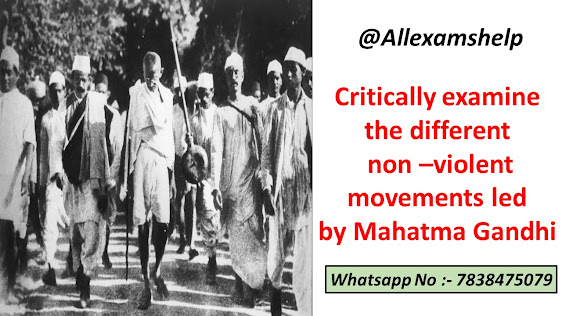Mahatma Gandhi was a prominent leader who advocated for nonviolent resistance and played a significant role in India's freedom struggle. He employed several nonviolent movements to bring about social and political change in India. In this response, we will examine the different nonviolent movements led by Mahatma Gandhi, their goals, tactics, and impact.
Champaran
Satyagraha (1917): The Champaran Satyagraha was the first nonviolent movement
led by Gandhi in India. The movement aimed to challenge the British
authorities' forced cultivation of indigo, which was ruining the lives of
farmers in Bihar. Gandhi mobilized the farmers and used his satyagraha tactics
to force the British authorities to repeal the Indigo Act.
Critically examine the
different non –violent movements led by Mahatma Gandhi
Non-Cooperation
Movement (1920-22): The Non-Cooperation Movement was a significant nonviolent
campaign launched by Gandhi in 1920. The movement aimed to boycott British
goods and institutions, including schools, courts, and government offices. The
movement's objective was to demand self-rule for India and create a sense of
nationalism among the people. The movement was successful in mobilizing
millions of Indians and brought India's struggle for independence to the
forefront.
Salt Satyagraha
(1930): The Salt Satyagraha was a pivotal movement led by Gandhi in 1930. The
movement aimed to challenge the British salt tax and promote Indian
self-sufficiency. Gandhi and his followers marched 240 miles to the Arabian Sea
to make salt, which was illegal under British rule. The movement sparked
widespread protests and led to the arrest of thousands of Indians, including
Gandhi himself. However, the movement was successful in gaining international
attention and putting pressure on the British to negotiate with Indian leaders.
Quit India
Movement (1942-44): The Quit India Movement was a mass civil disobedience
movement launched by Gandhi in 1942. The movement aimed to demand an end to
British rule in India and promote Indian self-rule. The movement was marked by
widespread protests, strikes, and acts of civil disobedience. The British
authorities responded with brutal force, and thousands of Indians were
arrested, including Gandhi. However, the movement inspired a sense of
nationalism among the people and forced the British to begin negotiations with
Indian leaders.
Overall, the
nonviolent movements led by Gandhi played a significant role in India's freedom
struggle. They inspired millions of Indians to challenge British rule
peacefully and promoted a sense of national unity among the people. Gandhi's
tactics of satyagraha, civil disobedience, and non-cooperation were effective
in mobilizing people and gaining international attention. The impact of these
movements is still felt in India today, where nonviolent resistance continues
to be an essential tool for bringing about social and political change.
I assume that
you are asking me to critically examine the different non-violent movements led
by individuals other than Mahatma Gandhi. In that case, here are a few
examples:
Civil Rights
Movement (1954-68) - led by Martin Luther King Jr. The Civil Rights Movement
was a nonviolent movement that aimed to challenge racial discrimination and
segregation in the United States. Led by Martin Luther King Jr., the movement
employed various tactics such as boycotts, marches, and sit-ins to demand equal
rights and an end to segregation. The movement was successful in achieving
significant legislative reforms, including the Civil Rights Act of 1964 and the
Voting Rights Act of 1965.
The Women's
Suffrage Movement (1848-1920) - led by Susan B. Anthony and Elizabeth Cady
Stanton The Women's Suffrage Movement was a nonviolent movement that aimed to
secure voting rights for women. The movement employed tactics such as rallies,
petitions, and hunger strikes to demand equal rights for women. The movement
was successful in securing the 19th Amendment to the U.S. Constitution in 1920,
which granted women the right to vote.
The
Anti-Apartheid Movement (1948-94) - led by Nelson Mandela The Anti-Apartheid
Movement was a nonviolent movement that aimed to challenge the system of racial
segregation and discrimination in South Africa. Led by Nelson Mandela, the
movement employed tactics such as boycotts, strikes, and civil disobedience to
demand equal rights and an end to apartheid. The movement was successful in
pressuring the South African government to dismantle the apartheid system and
in securing the release of Mandela from prison in 1990.
For SOLVED PDF & Handwritten
WhatsApp No :- 7838475019
The Arab Spring
(2010-12) - led by various leaders The Arab Spring was a nonviolent movement
that aimed to challenge authoritarian regimes in various countries in the
Middle East and North Africa. Led by various leaders, the movement employed
tactics such as mass protests, sit-ins, and social media to demand political reforms
and greater democracy. The movement was successful in toppling authoritarian
regimes in Tunisia, Egypt, and Libya, but it also led to instability and
conflict in some countries.
Overall, these
nonviolent movements led by individuals other than Mahatma Gandhi highlight the
power of nonviolent resistance in achieving social and political change. These
movements employed various tactics and strategies, but they all shared a
commitment to nonviolence and peaceful resistance. These movements provide valuable
lessons for activists and leaders around the world who seek to bring about
positive change in their societies.
